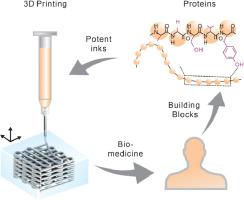Progress in Polymer Science ( IF 27.1 ) Pub Date : 2021-02-16 , DOI: 10.1016/j.progpolymsci.2021.101375 Xuan Mu 1 , Francesca Agostinacchio 1, 2 , Ning Xiang 1 , Ying Pei 1, 3 , Yousef Khan 1 , Chengchen Guo 1 , Peggy Cebe 4 , Antonella Motta 2 , David L Kaplan 1

|
Three-dimensional (3D) printing is a transformative manufacturing strategy, allowing rapid prototyping, customization, and flexible manipulation of structure-property relationships. Proteins are particularly appealing to formulate inks for 3D printing as they serve as essential structural components of living systems, provide a support presence in and around cells and for tissue functions, and also provide the basis for many essential ex vivo secreted structures in nature. Protein-based inks are beneficial in vivo due to their mechanics, chemical and physical match to the specific tissue, and full degradability, while also to promoting implant-host integration and serving as an interface between technology and biology. Exploiting the biological, chemical, and physical features of protein-based inks can provide key opportunities to meet the needs of tissue engineering and regenerative medicine. Despite these benefits, protein-based inks impose nontrivial challenges to 3D printing, such as sufficient concentration, rheological features, and structural hierarchy observed in nature that is a source of the robust mechanics and functions of these materials. This review introduces photo-crosslinking mechanisms and rheological principles that underpins a variety of 3D printing techniques. The review also highlights recent advances in the design, development, and biomedical utility of monolithic and composite inks from a range of proteins, including collagen, silk, fibrinogen, and others. One particular focus throughout the review is to introduce unique material characteristics of proteins, including amino acid sequences, molecular assembly, and secondary conformations for designing printing inks and for controlling the printed structures. Future perspectives of 3D printing with protein-based inks are also provided to support the promising spectrum of biomedical research accessible to these materials.
中文翻译:

蛋白质墨水 3D 打印的最新进展
三维 (3D) 打印是一种变革性的制造策略,可实现快速原型制作、定制以及灵活操纵结构-性能关系。蛋白质对于配制用于 3D 打印的墨水特别有吸引力,因为它们是生命系统的重要结构成分,为细胞内和细胞周围以及组织功能提供支持,并且还为自然界中许多重要的离体分泌结构提供了基础。基于蛋白质的墨水由于其力学、化学和物理与特定组织的匹配性以及完全可降解性而在体内有益,同时还可以促进植入物与宿主的整合并充当技术与生物学之间的界面。利用蛋白质墨水的生物、化学和物理特性可以为满足组织工程和再生医学的需求提供关键机会。尽管有这些优点,但蛋白质墨水给 3D 打印带来了不小的挑战,例如足够的浓度、流变特性和在自然界中观察到的结构层次,这是这些材料强大的力学和功能的来源。本综述介绍了支撑各种 3D 打印技术的光交联机制和流变原理。该评论还强调了由一系列蛋白质(包括胶原蛋白、丝、纤维蛋白原等)制成的整体和复合墨水在设计、开发和生物医学用途方面的最新进展。整个综述的一个特别重点是介绍蛋白质的独特材料特性,包括氨基酸序列、分子组装和用于设计印刷油墨和控制印刷结构的二级构象。还提供了基于蛋白质的墨水 3D 打印的未来前景,以支持这些材料可进行的有前景的生物医学研究。


























 京公网安备 11010802027423号
京公网安备 11010802027423号